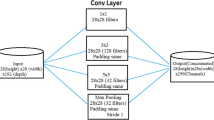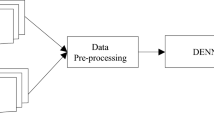Abstract
Diverse plant diseases have a major impact on the yield of food crops, and if plant diseases are not recognized in time, they may spread widely and directly cause losses to crop yield. In this work, we studied the deep learning techniques and created a convolutional ensemble network to improve the capability of the model for identifying minute plant lesion features. Using the method of ensemble learning, we aggregated three lightweight CNNs including SE-MobileNet, Mobile-DANet, and MobileNet V2 to form a new network called Es-MbNet to recognize plant disease types. The transfer learning and two-stage training strategy were adopted in model training, and the first phase implemented the initialization of network weights. The second phase re-trained the network using the target dataset by injecting the weights trained in the first phase, thereby gaining the optimum parameters of the model. The proposed method attained a 99.37% average accuracy on the local dataset. To verify the robustness of the model, it was also tested on the open-source PlantVillage dataset and reached an average accuracy of 99.61%. Experimental findings prove the validity and deliver superior performance of the proposed method compared to other state-of-the-arts. Our data and codes are provided at https://github.com/xtu502/Ensemble-learning-for-crop-disease-detection.






Similar content being viewed by others
References
Atoum Y, Afridi MJ, Liu X, McGrath JM, Hanson LE (2016) On developing and enhancing plant-level disease rating systems in real fields. Pattern Recognit 53:287–299
Barbedo JG (2018) Factors influencing the use of deep learning for plant disease recognition. Biosyst Eng 172:84–91
Chen J, Wang W, Zhang D, Zeb A, Nanehkaran YA (2021a) Attention embedded lightweight network for maize disease recognition. Plant Pathol 70(3):630–642
Chen J, Zhang D, Suzauddola M, Nanehkaran YA, Sun Y (2021b) Identification of plant disease images via a squeeze-and-excitation MobileNet model and twice transfer learning. IET Image Proc 15(5):1115–1127
Chen J, Zhang D, Zeb A, Nanehkaran YA (2021c) Identification of rice plant diseases using lightweight attention networks. Expert Syst Appl 169:1–12
Chouhan SS, Kaul A, Singh UP, Jain S (2018) Bacterial foraging optimization based radial basis function neural network (BRBFNN) for identification and classification of plant leaf diseases: an automatic approach towards plant pathology. IEEE Access 6:8852–8863
Chug A, Bhatia A, Singh AP, Singh D (2022) A novel framework for image-based plant disease detection using hybrid deep learning approach. Soft Comput 1–26
Coulibaly S, Kamsu-Foguem B, Kamissoko D, Traore D (2019) Deep neural networks with transfer learning in millet crop images. Comput Ind 108:115–120
Ding W, Taylor G (2016) Automatic moth detection from trap images for pest management. Comput Electron Agric 123:17–28
Doan TS (2017) Ensemble learning for multiple data mining problems. University of Colorado at Colorado Springs. PhD thesis
Elhassouny A, Smarandache F (2019) Smart mobile application to recognize tomato leaf diseases using Convolutional Neural Networks. In: 2019 international conference of computer science and renewable energies (ICCSRE). IEEE, pp 1–4
Gandhi R, Nimbalkar S, Yelamanchili N, Ponkshe S (2018) Plant disease detection using CNNs and GANs as an augmentative approach. In: 2018 IEEE international conference on innovative research and development (ICIRD). IEEE, pp 1–5
Geetharamani G, Pandian A (2019) Identification of plant leaf diseases using a nine-layer deep convolutional neural network. Comput Electr Eng 76:323–338
Hari SS, Sivakumar M, Renuga P, Suriya S (2019) Detection of plant disease by leaf image using convolutional neural network. In: 2019 international conference on vision towards emerging trends in communication and networking (ViTECoN). IEEE, pp 1–5
Hassan SM, Maji AK (2022) Plant disease identification using a novel convolutional neural network. IEEE Access 10:5390–5401
He K, Zhang X, Ren S, Sun J (2016) Deep residual learning for image recognition. In: Proceedings of the IEEE conference on computer vision and pattern recognition, pp 770–778
Huang G, Liu Z, Van Der Maaten L, Weinberger KQ (2017) Densely connected convolutional networks. In: Proceedings of the IEEE conference on computer vision and pattern recognition, pp 4700–4708
Hughes D, Salathé M (2015) An open access repository of images on plant health to enable the development of mobile disease diagnostics. http://arxiv.org/abs/1511.08060
Jayagopal P, Rajendran S, Mathivanan SK, Sathish Kumar SD, Raja KT, Paneerselvam S (2022) Identifying region specific seasonal crop for leaf borne diseases by utilizing deep learning techniques. Acta Geophys pp 1–14
Karthik R, Hariharan M, Anand S, Mathikshara P, Johnson A, Menaka R (2020) Attention embedded residual CNN for disease detection in tomato leaves. Appl Soft Comput 86:1–27
Kaur S, Pandey S, Goel S (2018) Semi-automatic leaf disease detection and classification system for soybean culture. IET Image Proc 12(6):1038–1048
Kingma DP, Ba J (2014) Adam: a method for stochastic optimization. http://arxiv.org/abs/1412.6980
Kumari CU, Prasad SJ, Mounika G (2019) Leaf disease detection: feature extraction with K-means clustering and classification with ANN. In: 2019 3rd international conference on computing methodologies and communication (ICCMC). IEEE, pp 1095–1098
Li X, Zhang S, Jiang B, Qi Y, Chuah MC, Bi N (2019) Dac: data-free automatic acceleration of convolutional networks. In: 2019 IEEE Winter conference on applications of computer vision (WACV). IEEE, pp 1598–1606
Liang Q, Xiang S, Hu Y, Coppola G, Zhang D, Sun W (2019) PD2SE-Net: computer-assisted plant disease diagnosis and severity estimation network. Comput Electron Agric 157:518–529
Lu Y, Yi S, Zeng N, Liu Y, Zhang Y (2017) Identification of rice diseases using deep convolutional neural networks. Neurocomputing 267:378–384
Mohan KJ, Balasubramanian M, Palanivel S (2016) Detection and recognition of diseases from paddy plant leaf images. Int J Comput Appl 144(12):34–41
Mohanty SP, Hughes DP, Salathé M (2016) Using deep learning for image-based plant disease detection. Front Plant Sci 7:1–10
Qi H, Liang Y, Ding Q, Zou J (2021) Automatic identification of peanut-leaf diseases based on stack ensemble. Appl Sci 11(4):1–14
Russakovsky O, Deng J, Su H, Krause J, Satheesh S, Ma S, Fei-Fei L (2015) Imagenet large scale visual recognition challenge. Int J Comput vis 115(3):211–252
Sandler M, Howard A, Zhu M, Zhmoginov A, Chen LC (2018) Mobilenetv2: inverted residuals and linear bottlenecks. In: Proceedings of the IEEE conference on computer vision and pattern recognition, pp 4510–4520
Selvaraju RR, Cogswell M, Das A, Vedantam R, Parikh D, Batra D (2017) Grad-cam: visual explanations from deep networks via gradient-based localization. In: Proceedings of the IEEE international conference on computer vision, pp 618–626
Sethy PK, Barpanda NK, Rath AK, Behera SK (2020) Deep feature based rice leaf disease identification using support vector machine. Comput Electron Agric 175:1–9
Sifre L (2014) Rigid-motion scattering for image classification. Ecole Polytechnique, CMAP. PhD thesis
Simonyan K, Zisserman A (2014) Very deep convolutional networks for large-scale image recognition. http://arxiv.org/abs/1409.1556
Szegedy C, Vanhoucke V, Ioffe S, Shlens J, Wojna Z (2016) Rethinking the inception architecture for computer vision. In: Proceedings of the IEEE conference on computer vision and pattern recognition, pp 2818–2826
Szegedy C, Ioffe S, Vanhoucke V, Alemi AA (2017) Inception-v4, inception-ResNet and the impact of residual connections on learning. In: Thirty-first AAAI conference on artificial intelligence(AAAI-17), pp 4278–4284
Tm P, Pranathi A, SaiAshritha K, Chittaragi NB, Koolagudi SG (2018) Tomato leaf disease detection using convolutional neural networks. In: 2018 eleventh international conference on contemporary computing (IC3). IEEE, pp 1–5
Tuncer A (2021) Cost-optimized hybrid convolutional neural networks for detection of plant leaf diseases. J Ambient Intell Humaniz Comput 12(8):8625–8636
Wenchao X, Zhi Y (2022) Research on strawberry disease diagnosis based on improved residual network recognition model. Math Probl Eng 2022:1–12
Zeng T, Li C, Zhang B, Wang R, Fu W, Wang J, Zhang X (2022) Rubber leaf disease recognition based on improved deep convolutional neural networks with an cross-scale attention mechanism. Front Plant Sci 274:1–12
Acknowledgements
The authors want to thank Fundamental Research Funds for the Central Universities with Grant No. 20720181004. The authors also thank editors and unknown reviewers for providing useful suggestions.
Author information
Authors and Affiliations
Corresponding authors
Additional information
Publisher's Note
Springer Nature remains neutral with regard to jurisdictional claims in published maps and institutional affiliations.
Rights and permissions
Springer Nature or its licensor holds exclusive rights to this article under a publishing agreement with the author(s) or other rightsholder(s); author self-archiving of the accepted manuscript version of this article is solely governed by the terms of such publishing agreement and applicable law.
About this article
Cite this article
Chen, J., Zeb, A., Nanehkaran, Y.A. et al. Stacking ensemble model of deep learning for plant disease recognition. J Ambient Intell Human Comput 14, 12359–12372 (2023). https://doi.org/10.1007/s12652-022-04334-6
Received:
Accepted:
Published:
Issue Date:
DOI: https://doi.org/10.1007/s12652-022-04334-6




